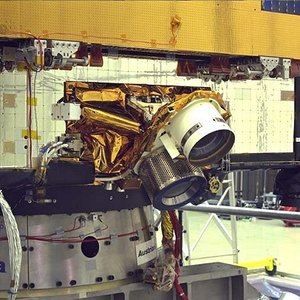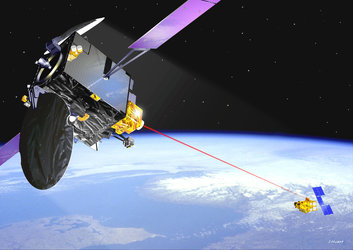A world first : Data transmission between European satellites using laser light
ESA PR 69-2001. Last night, for the first time, a data link between satellites was established using a laser beam as signal carrier. On board ESA's Artemis satellite - launched last July by an Ariane 5 - is the SILEX system. This system provides an optical data transmission link with the CNES Earth observation satellite SPOT 4, which is orbiting the earth at an altitude of 832 km while Artemis is temporarily in a parking orbit at 31 000 km.
Through the laser data link, images taken by SPOT 4 can be transmitted in real time to the image processing centre at Spot Image in Toulouse, France, via Artemis, thus drastically reducing the time between taking the picture and its delivery to the centre. This is possible whenever the two satellites are in line of sight. Without the Artemis relay the images are stored on board in SPOT 4's memory and dumped to the ground stations.
The experiment performed last night consisted in establishing the link four times: in the course of four successive SPOT 4 orbits, the SILEX terminal on board Artemis activated its optical beacon to scan the area where SPOT was expected to be. When contact was made, SPOT 4 responded by sending its own laser beam to Artemis. On receiving the SPOT 4 beam, Artemis stopped scanning and the optical link was maintained for a pre-programmed period lasting from 4 to 20 minutes.
During the period when the two satellites were "communicating", test data were transmitted from SPOT 4 to the ground via Artemis at a rate of 50 000 000 bits per second (50 Mbps). The extremely high accuracy of the data stream was confirmed at ESA's test station in Redu (Belgium) and the SPOT 4 receive station in Toulouse.
The main challenge in establishing an optical link between satellites is to point a very narrow beam with extreme accuracy to illuminate the partner spacecraft flying at a speed of 7000 m/s. Last night's experiment was performed under worst-case conditions since Artemis is not in its nominal geostationary position but in an lower parking orbit, circling the Earth every 19 hours.
Last night's experiment was preceded by a series of tests a week earlier, during which a link was established between Artemis and ESA's optical ground station in Tenerife. Thoses tests demonstrated the correct operation of the SILEX terminal and paved the way for the subsequent steps.
Another preparatory test will be performed over the weekend. The first experimental transmission of a SPOT 4 image is planned for early December. Before Christmas, the ion-propulsion phase is expected to start moving Artemis to its final geostationary orbit at 36 000 km. Once the spacecraft has reached that orbit, in the middle of next year, the operational phase will begin and the link between the two satellites will be established at least 5 times a day.
The SILEX system consists of two terminals: one on board Artemis, the other on SPOT 4. Both terminals were designed and built by Astrium. The definition and procurement of the system were conducted in close cooperation between ESA and the French space agency, CNES.
Artemis is an advanced communication satellite built under the leadership of Alenia Spazio (Italy). The satellite is operated from a control station in Fucino (Italy) by the Italian consortium Altel (Alenia Spazio/Telespazio). The test was organised and technically supported by an ESA team at Redu (Belgium) and an Astrium team at Fucino in close cooperation with the CNES SPOT 4 operational team in Toulouse.
For further information, please contact :
ESA Communication Department
Media Relations Office
Tel: +33(0)1.53.69.7155
Fax: +33(0)1.53.69.76.90
Gotthard Oppenhäuser
ESA/ESTEC
Artemis Project Manager
Tel: +31.71.565.3168







